Digital technologies now increasingly pervade both business and everyday life. Employees and customers alike, whether business or consumers, draw their expectations from digital experiences. And techniques like big data and AI are obviously impossible without digitization.
So many organizations turn to their legacy systems and seek to transform them. But without a secure, clear-eyed strategy for success, they’re likely to be disappointed. In this post, we’ll examine what digital transformation strategy is, why your business needs one, and what it should contain.
What is digital transformation?
Digital transformation is the process of moving an organization’s operations and assets onto a digital substrate. It’s not the same as digitizing an element of the organization: digitizing the archive of a newspaper isn’t a digital transformation. But when that newspaper shifts the majority of its work, publication, advertising, and feedback mechanisms onto digital substrates, it’s digitally transformed.
Doing this in a controlled, planned way is increasingly crucial. Everything from basic communications to productivity is digital by default now, meaning partners, clients and competitors are all there or getting there. But doing it in an uncontrolled way is a recipe for catastrophe.
Relatively few digital transformation efforts are successful: even in tech or tech-adjacent industries, only 26% of respondents told McKinsey that they’d seen successful transformations.
What is strategy?
At first glance, this seems like an obvious question. Methods to achieve long-term goals sounds like it should cover it. But it’s worth pausing here for a moment and considering just what we actually do mean by strategy. In a seminal piece for HBR, Michael E Porter, founder of the modern strategy field and director of Harvard’s Institute for Strategy and Competitiveness, delineated the difference between operational effectiveness in alignment with long-term goals, and actual strategy.
To retain a long-term competitive advantage, says Porter, businesses can’t just focus on ‘a series of races down identical paths that no-one can win.’ Instead, they should ‘perform activities differently or… perform different activities than rivals,’ seeking ‘new positions that woo customers.’
Porter was talking about whole-business strategy, not the strategic element of digital transformation. But the points he makes remain valid, and relevant. Best practice for digital transformation will get you so far; selecting products, services and integrations that gel with your business strategy — the different activities you perform to better serve your customers — turns table stakes into a source of long-term competitive advantage.
Why do you need a digital transformation strategy?
Horror stories of unplanned or poorly planned digital transformations abound. Poor planning and execution decisions, arising ultimately from poor strategizing, lead to outcomes like these.
We want to get the benefits of successful digital transformation while avoiding the roadblocks and pitfalls. Doing that requires an end-to-end digital transformation strategy, which is what this post is about.
Digital transformation strategies are roadmaps to successful digital transformations. They lay out:
- What’s wrong? Why transform at all? How do the current structure and processes fall short?
- Where to aim for. What is the definition of success? For many businesses, they’ll opt to digitize all their core operations and data handling simultaneously, moving to new self-hosted or cloud services that replace everything from faxes and file cabinets to traditional phone services.
- What route to take and where the staging posts are. How do you know whether you’re on track? What do you need to check off the list to make sure you’re on time and on target?
- What to avoid. Where are the common errors and mishaps in a process like this, and how do you avoid falling into them?
They’re designed to allocate resources, including skills, and to ‘fail safe,’ preventing the possibility of the business not being able to function or of the project being delivered inoperable. They’re also designed to match your business needs with the available tools and processes, rather than getting infrastructure ‘off the rack’ and finding it doesn’t fit with your needs.
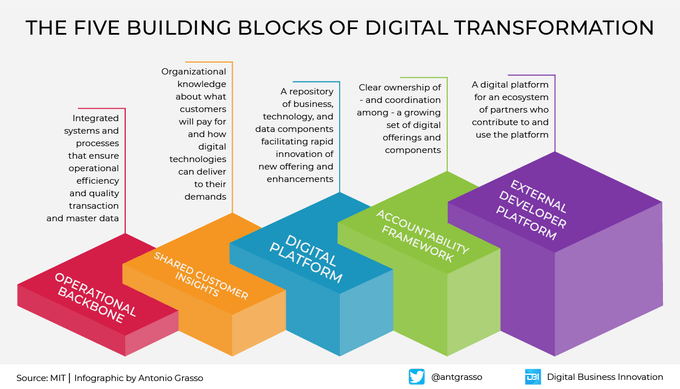
What are the four main areas of digital transformation strategy?
In May 2020, Thomas H. Davenport and Thomas C. Redman wrote in HBR that ‘Digital transformation comes down to talent in 4 key areas… technology, data, process, [and] organizational change capability.’ They’re interrelated, and without all of them, the project will likely fail.
Technological transformation and technical debt
Many companies have significant technical debt, in the form of legacy systems which are either mission-critical, or the company and its staff are habituated to relying on. What makes it harder to pay this debt is that many businesses default to a mode of operation in which IT is mainly concerned with maintenance and repair rather than driving change. End users and management alike often have little real faith in the ability of IT departments to rebuild systems, and take an essentially conservative attitude: don’t touch it, in case it gets worse.
Digital transformation requires businesses to transform themselves. Managers must accept that IT staff can effect such changes, often in collaboration with outside resources. IT staff must believe that managers will let them and support them in doing so.
Data, structure and process
The average business has poor data management techniques and structures. Some forward-looking companies talk about integrating all their data across their tech stack; for most businesses, the reality is one of data silos by department and negligible capacity to process unstructured data.
Transforming the business digitally also means transforming the way the business thinks about data, moving to modern data management techniques that reduce or fully de-silo and make non-structured data useable for business purposes.
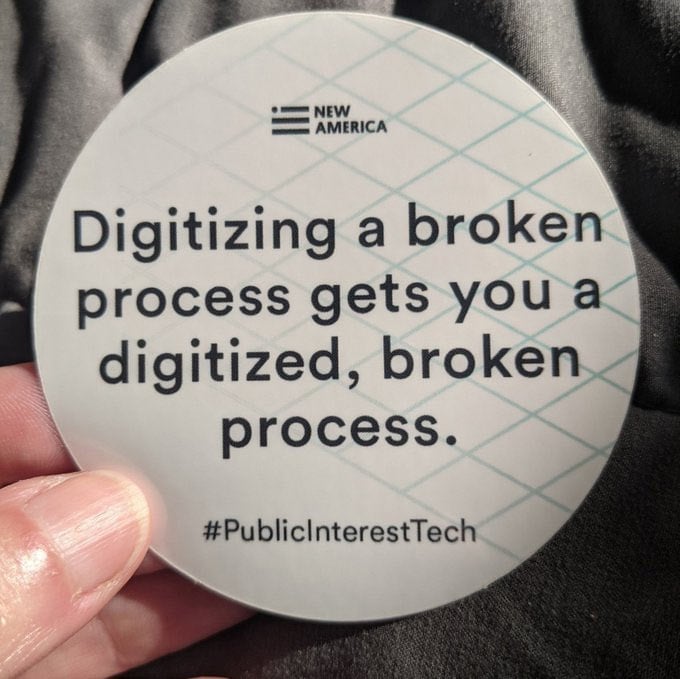
The goal here is not to take the same processes you’re currently doing and digitize them. It’s to gain access to new benefits that can only be acquired through digitization.
Business process and structure
Data silos don’t exist in a vacuum; they owe their existence to organizational culture, and they take their form from the organization's structure.
No one’s suggesting that you have to get rid of specialized functions and have everyone work on everything, that’s obviously unworkable and a terrible idea; but you should focus on getting the entire business aligned around whole-business goals and start breaking down siloed thinking and attitudes.
Change management and capability
Making this work means rethinking structures and cultures within the company, many of which have traditionally been their own smaller entities in a traditional org chart. Breaking down those structures and realigning the company around its goals instead of its own internal structure means abandoning a lot of traditional hierarchy, and is best done by people with the skillset to be persuasive and transfer enthusiasm, not just pass on instructions.
Back in 2005, Harold L. Sirkin, Perry Keenan, and Alan Jackson wrote for HBR that decisive factors in change management could be divided into two groups: hard and soft factors.
Soft factors referred to the soft interpersonal skills and issues like company culture, which the authors don’t deny are of crucial importance. Hard factors referred to factors that could be quantified, communicated, and changed or influenced quickly.
The authors referred to these as Duration, Integrity, Commitment and Effort, or DICE for short, and credited attention to them with predicting project outcomes better than any other approach.
What does a great digital transformation strategy look like?
Successful digital transformations are likely to leverage a wider range of technologies, and to have buy-in from more disparate groups and specialisms within the organization. For instance, when comparing most and least successful digital transformation journeys:
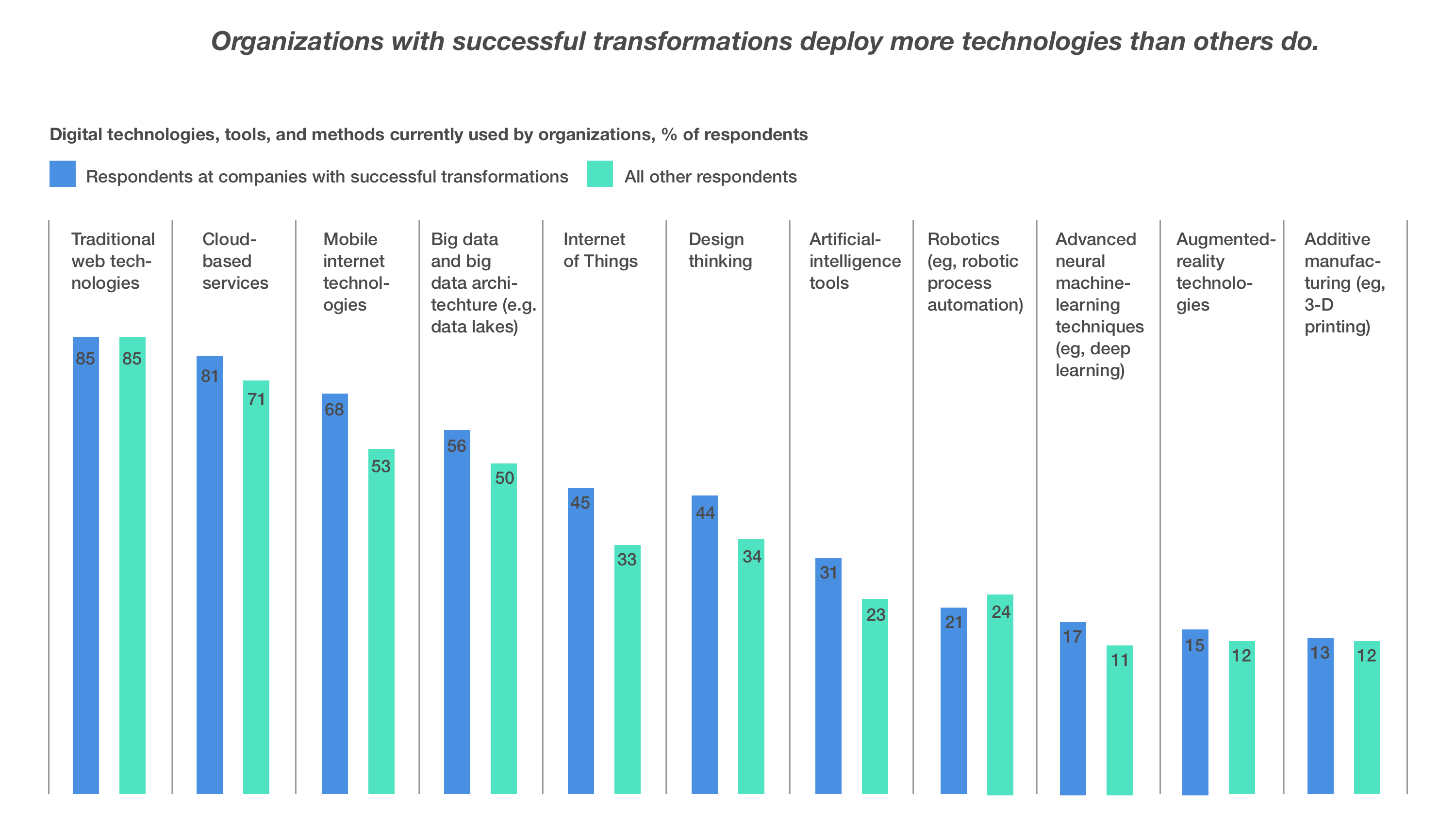
At first glance, this seems like the opposite of what we’d expect: a scattergun approach might lead to wasted resources and lost opportunities, and a more complex transformation with more points of failure and bottlenecks. All of which may be true, but is offset by the skew toward more sophisticated technologies in more successful transformations.
It’s also worth pointing out that these are often leveraging a wider range of technologies to achieve deeper, more systemic organizational change, rather than viewing the process as ‘getting a new computer system’ or ‘moving everything to the cloud.’
Many businesses don’t have the in-house expertise to do this; those who reach out to third-party experts often achieve better results.
The other major finding from the same McKinsey report is that organizations with successful digital transformations have more buy-in from a wider range of stakeholders across the organization.
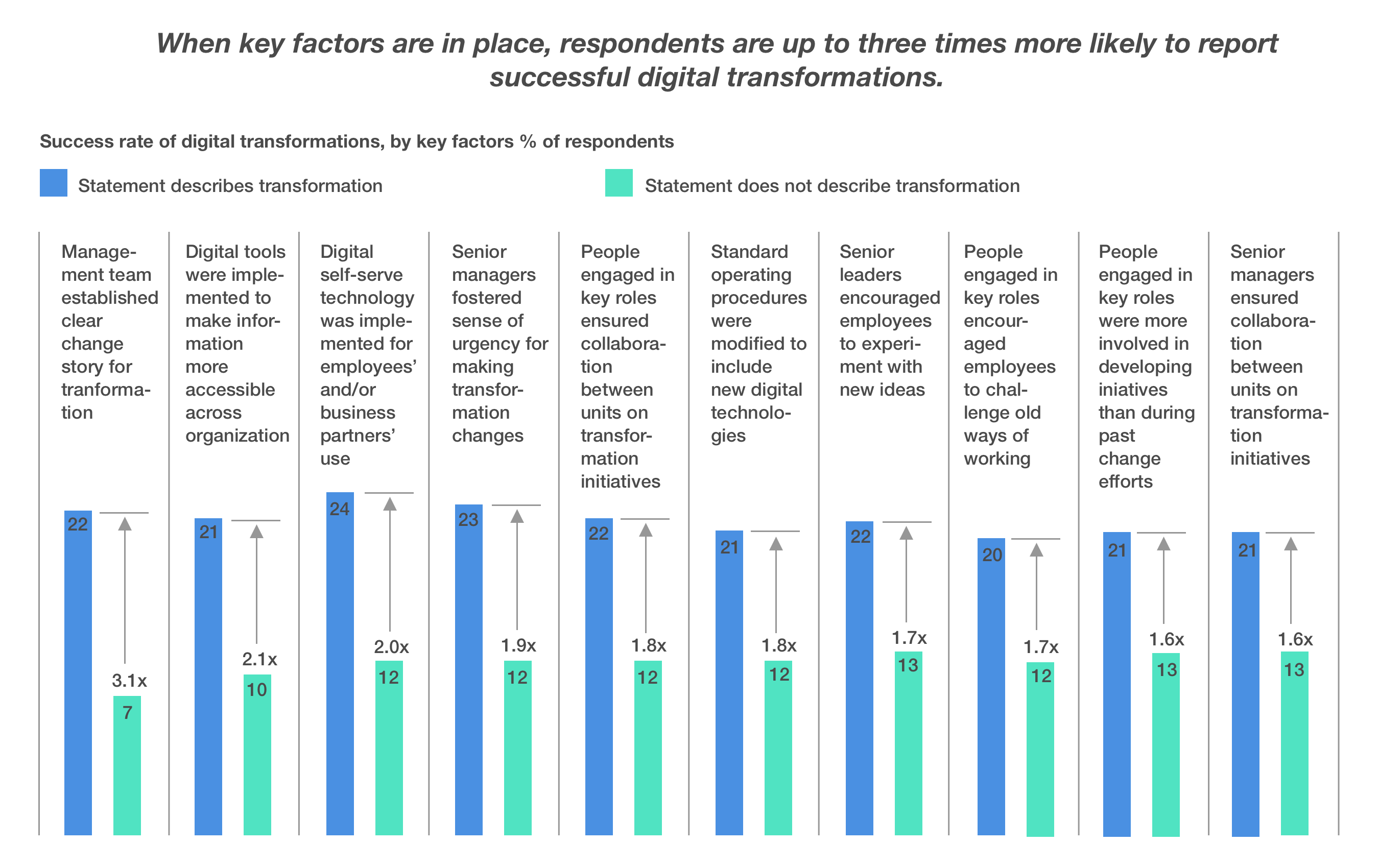
It’s here that some of the most significant differences can be seen. A clear narrative for the transformation, information being de-siloed, leaders and managers involved, and cross-unit collaboration all emerge as decisive.
How to design a digital transformation strategy
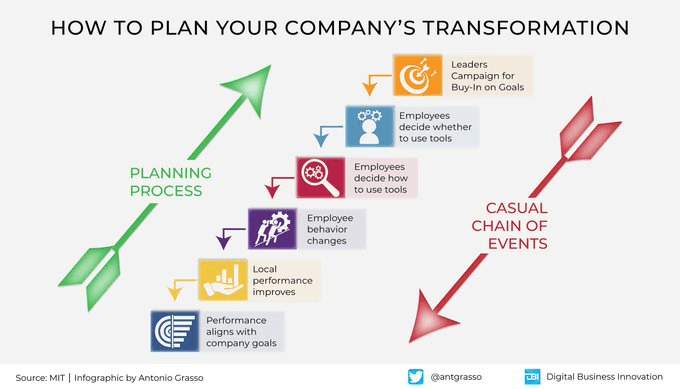
We’ve seen that you need a digital transformation strategy to make sure your transformation goes well, and to make sure it goes where your company is trying to go. Great digital transformation strategies include three ‘kernels,’ according to UCLA Emeritus Professor of Business and Society Richard Runmelt. In his 2011 book Good Strategy, Bad Strategy, Runmelt emphasizes that strategy isn’t goals or objectives, but the plan for how to successfully arrive at them: it’s a map of the journey, not the destination.
While your digital transformation goals will differ from other companies, we can generalize about how to create a good map. In fact, we can lean once again on Professor Runmelt’s work to do so.
Professor Runmelt’s book tells us that there are three key kernels that go into making a good strategy:
- Diagnosis
- Guiding Policy
- Coherent plan of action
At the diagnosis stage, you need to determine what additional functionality you need to achieve business goals. Skip this step, and you get prestige projects that don’t do anything, or the kind of digital transformation that solves superficial problems while exacerbating deep-rooted ones.
Guiding policy exists so everyone knows how to accomplish their tasks. How exactly do you want me to do X? If people don’t know the answer they’ll make up their own, and the results are seldom optimal.
A coherent plan of action is there to make sure things actually happen, on budget and on schedule. Without one, nothing much will get done. Tasks aligned to distant outcomes tend to get bumped down the list in favor of extinguishing the day’s fires.
Takeaways:
- Know why you’re seeking digital transformation
- Know what your definition of successful transformation looks like
- Get key personnel and leaders on board, enthusiastic and educated about the process and the outcome
- De-silo the organization, not just the data: get people developing their own cross-unit networks to get the job done
- View digital transformation as organizational transformation that happens to be digital
- Seek expert help identifying the appropriate methods and technologies for your business
















